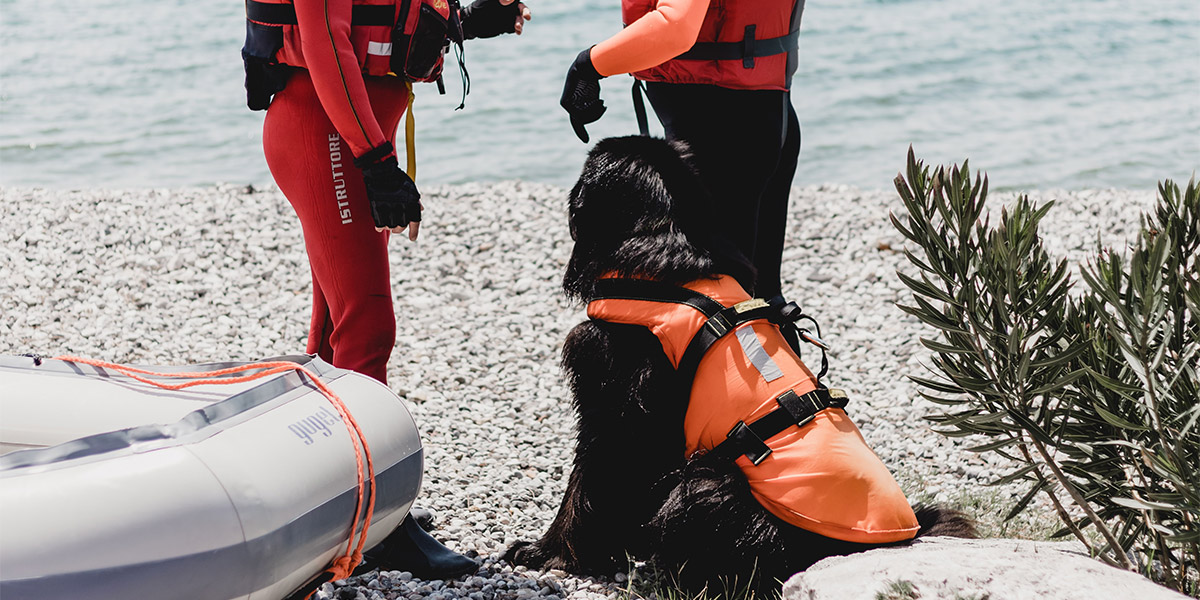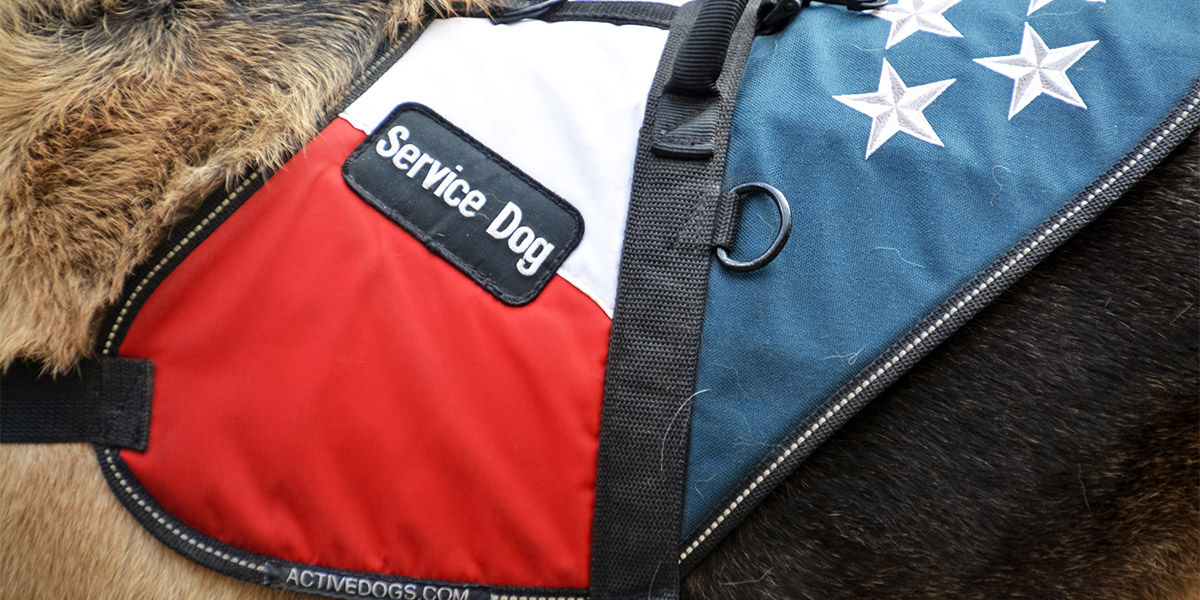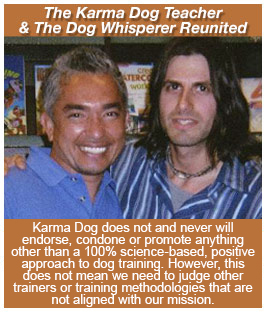Service Dogs
A gentle, effective, and enlightened approach to dog training
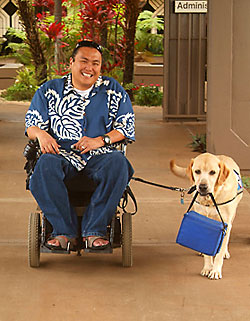
If you are ready to contact us about our various Service Dog programs, the fastest way to reach our Service Dog division directly is fill out our 30 second quick application on the left hand side of this web page.
Once you press "Send" your contact information gets routed directly to our Service Dog division, where we'll be able to provide you with a Price List as well as a way for all your Service Dog questions to be answered personally by one of our Service Dog Specialists!
Dogs have proven their usefulness to humans for centuries, and no more so than in becoming service dogs. Knowing what it takes to have your dog trained as a service dog, and more importantly designated as a service dog, will make your life much easier no matter what your handicap.
Service animal means any dog that is individually trained to do work or perform tasks for the benefit of an individual with a disability, including a physical, sensory, psychiatric, intellectual, or other mental disability. The work or tasks performed by a service animal must be directly related to the individual´s disability.
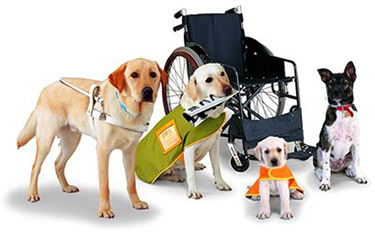
Examples of work or tasks include, but are not limited to, assisting individuals who are blind or have low vision with navigation and other tasks, alerting individuals who are deaf or hard of hearing to the presence of people or sounds, providing non-violent protection or rescue work, pulling a wheelchair, assisting an individual during a seizure, alerting individuals to the presence of allergens, retrieving items such as medicine or the telephone, providing physical support and assistance with balance and stability to individuals with mobility disabilities, and helping persons with psychiatric and neurological disabilities by preventing or interrupting impulsive or destructive behaviors. The crime deterrent effects of an animal´s presence and the provision of emotional support, well-being, comfort, or companionship do not constitute work or tasks for the purposes of this definition.
Comfort animals are pets that owners keep with them for emotional reasons (the owner may feel calmer when he or she is near the pet) do not qualify under the latest legal definition as a Service animal. Unlike a service animal, a comfort animal is not trained to perform specific tasks directly related to the person's disability. Common tasks for service animals include flipping light switches, picking up dropped objects, alerting the person to an alarm, or similar disability-related tasks. A service dog may still provide help to people with psychiatric disabilities, but the dog must be trained to perform specific actions, such as distracting the person when he becomes anxious or engages in stimming or other behaviors related to his disability.
Some fun facts you should know:
- Only dogs will be recognized as service animals.
- Service animals are required to be leashed or harnessed except when performing work or tasks where such tethering would interfere with the dog's ability to perform.
- Service animals are exempt from breed bans as well as size and weight limitations.
- Dogs whose sole function is “the provision of emotional support, well-being, comfort, or companionship” are not considered service dogs under the ADA.
- The use of service dogs for psychiatric and neurological disabilities is explicitly protected under the ADA.
- “The crime deterrent effects of an animal's presence” do not qualify that animal as a service animal and “an animal individually trained to provide aggressive protection, such as an attack dog, is not appropriately considered a service animal.”
WHAT KIND OF DOGS MAKE A GOOD SERVICE DOG?

Desirable character traits in service animals typically include good temperament or psychological make-up (including biddability and trainability) and good health (including physical structure and stamina). Service dogs are often trained and bred by service dog organizations, however, individual companies like Karma Dog Training have started to train service dogs.
Labrador Retrievers, German Shepherds,Golden Retrievers, and in recent years American Pit Bull Terriers are the most common breeds used as service dogs, but any breed or mix of breeds is capable of being a service dog, though few dogs have all of the health and temperament qualities needed.
SERVICE DOG ETIQUETTE

Most owners expect their service dogs to be treated as a working animal while in public. The health and safety of their owner may depend on the dog's ability to focus and resist distraction. Many service dogs are trained to avoid distraction when wearing their gear, but relax and are friendly when the gear is removed. An owner will expect to be asked for permission before another individual interacts with the dog.
Training
By definition, a service dog is a dog that is individually trained to perform tasks that mitigate the disability of the dog's owner. Since each person experiences a disability differently and therefore has different needs for assistance, each dog is to some extent custom-trained for the individual it will be helping. For example, a dog meant to assist a person in a wheelchair might be taught to pick up dropped items, open and close doors, and turn on and off lights. A dog trained to assist a person who cannot see well might be taught to avoid obstacles.
Puppy training
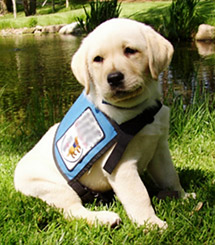
Service dog puppies are often fostered by their programs to private families to be reared until they are old enough for advanced training. During this time, the puppies are socialized through extensive interactions with people of all kinds (with variations in age, gender, ethnicity, mode of dress, disability, etc.) as well as with other common domestic animals, especially other dogs. Puppies are also habituated by their foster families so that they become comfortable in a wide variety of situations. The foster families, called puppy raisers or puppy walkers, take responsibility for teaching the pup basic life skills common to any well-behaved dog including basic obedience and manners. As examples, puppies in training to be service dogs typically have careful toilet training because they can go so many places that other animals cannot; behaviors that make the dogs easy to be around are also taught, such as not begging or jumping up on people, waiting at doors, riding in cars, coming when called, sitting, lying down, staying in different positions, and walking politely on a leash.
In recent years, many organizations have involved inmates in prisons for some initial puppy training. There are pros and cons to this move. For example, without the responsibilities of making a living, paying bills, driving the kids, etc., inmates typically have more time to spend with the puppy. There is a lot of walking in prison, and inmate-raised puppies thus have more opportunities to walk on a loose leash. In contrast, the early socialization that is a must for puppies is limited in a prison: all men, or all women, all dressed the same, few if any children, and a lack of new and various scents. Cars, bicycles, skateboards, backpacks, cats, and many other distractions are rare to non-existent in prisons. Still, these programs have been a success on many fronts with the help of professionals, and some forethought on program implementation.
Also, there is owner training, in which the disabled person does the training, from start to finish, without the help of a program. Not all SDs are program dogs.
Advanced training
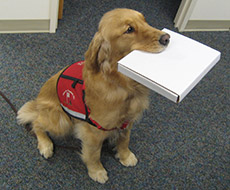
A service dog handing keys to his owner. Puppies are periodically tested during the fostering period but are more thoroughly evaluated once they are returned to the training center, usually between 12 and 18 months of age. They are evaluated for temperament and health traits. Those not up to the standard are offered for adoption or are transferred to programs for other service dogs such as police or search and rescue. Generally, the family that fostered the puppy is given the first option to keep any pup that does not continue in the program.
The next stage is typically done by professional trainers with expertise in training dogs for particular disabilities. As examples, guide dogs will need skills different from dogs that work with developmentally disabled children. Core skills shared by all public access service dogs include proofing to work in spite of distractions and generalization to work in a variety of venues. All service dogs need to learn a working position, usually the heel position, which the dog is responsible for maintaining regardless of how the owner moves and whether or not a leash is dropped. They are taught to toilet only on command when working.
Core skills and tasks are generally taught during the same period when the dog is kept at the training center to work with professional service dog trainers. Another phase, called public access training, is proofing and generalization or teaching the dog to perform his duties without regard for distraction and in any environment. Advanced training can last six months to one year, but a number of organizations are working to decrease the length of this phase in order to increase the service dog's working period.
Program-trained dogs vs. owner-trained dogs
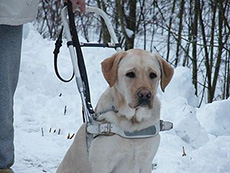
A growing number of people choose to train their own service dogs. This can be because existing programs do not answer their needs (for example, a dog that can help someone in a wheelchair who is also hard of hearing). It can also be because the disabled person wants to experience the dog's puppyhood, or because he or she already has a pet dog when the need for a service dog arises, as well as owner training being significantly less expensive than professional training. This is permitted in some countries, such as the U.S., but not in all. Handlers with experience training advanced dogs may choose to train the dogs themselves, while others may employ a professional trainer or organization that accepts an owner's existing dog.
Program-trained dogs are matched with their future handler near the end of the training process. By this point, it is nearly certain the candidate dog will complete training and will become a service dog. Owner-trainers often start working with their puppies while they are very young, too young to be thoroughly evaluated. Owner-trainers whose puppies fail to measure up must deal with the emotional conflict of whether to re-home the dog or keep him as a pet.
Because most programs now breed their own puppies and raise them according to very carefully researched and planned guidelines, their success rates are relatively high. Owner-trainers, lacking the experience of the program trainers and not being able to manipulate the genetics or early neurological stimulation of the puppies, generally experience a lower success rate.
However, for a person with the skill to train their own service dog, this option can make dogs of specific breeds available that would not be available through a program, and allows for greater customization of training. For a handler used to a certain set of command words or who needs a cross-disability dog, this can be a very useful option.
Americans with disabilities act of 1990

Disabled owners of service dogs are protected under the Americans with Disabilities Act of 1990, which generally gives them the right to be accompanied by their service animal anywhere the general public is allowed. Additional federal laws protect people with disabilities partnered with service animals, as well as other types of assistance animals, from discrimination in housing (the Fair Housing Amendments Act and on aircraft (the Air Carrier Access Act. Actually, the Air Carrier Access Act does not define "service animal" and it is a misnomer that the ACAA provides a broader definition of the term over the ADA.
Under the ADA, businesses are permitted to deny access to service dogs that are not behaving properly. They may also be excluded if the presence of the animal constitutes a fundamental alteration of the business or poses a direct threat. Persons with service dogs are not required to pay any additional fees on account of the service dog, though the owner is responsible for any damages caused by the dog.
Service dogs may wear special vests or ID tags, but they are not a requirement of the ADA.
LIFE OF A SERVICE DOG
Red Cross service dog in Italy, January 1909. The typical working life of a service dog is usually eight to ten years, depending on the owner's needs and preferences.
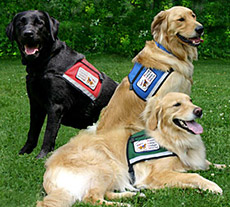
Service dogs are free to act normally when they are not working. Typically, the animals are taught to identify work versus free time by whether or not they are wearing their gear. Exceptions to this rule may exist, such as a seizure alert dog, which must not ignore an impending seizure even when it is not wearing its gear. Nevertheless, just as with any other trained animal, working dogs must still obey commands even when they are off-duty. Because of the strict behavior expected from a working dog when it is on duty, many owners will usually not permit people to pet the animal, or are reluctant to remove gear on request (such as for security inspections.)
When a service dog retires, it may remain with his owner or a family member as a pet. If the owner is unable to care for him and a successor dog at the same time, he may be returned to the program for "re-homing." Typically, the family that raised it as a puppy is given the first opportunity to keep him as a pet. Others are adopted out to carefully screened homes. These dogs are highly desirable pets because of their manners and obedience training; waiting lists for such placements may sometimes be measured in years.
PSYCHIATRIC SERVICE DOG

A psychiatric service dog is a specific type of service dog trained to assist their handler with a psychiatric disability, such as post-traumatic stress disorder or schizophrenia. Although assistance dogs have traditionally helped people with disabilities such as blindness or more recently deafness or mobility disabilities, there is a wide range of other disabilities that an assistance dog may be able to help with as well, including psychiatric disabilities.
Like all assistance dogs, a psychiatric service dog is individually trained to do work or perform tasks that mitigate their handler's disability. Training to mitigate a psychiatric disability may include providing environmental assessment (in such cases as paranoia or hallucinations), signaling behaviors (such as interrupting repetitive or injurious behaviors), reminding the handler to take medication, retrieving objects, guiding the handler from stressful situations, or acting as a brace if the handler becomes dizzy.
Psychiatric service dogs may be of any breed or size suitable for public work. Many psychiatric service dogs are trained by the person who will become the handler—usually with the help of a professional trainer. Others are trained by assistance or service dog programs. Assistance dog organizations are increasingly recognizing the need for dogs to help individuals with psychiatric disabilities, and there are even organizations dedicated specifically to supporting psychiatric service dog handlers.
ACCESSIBILITY
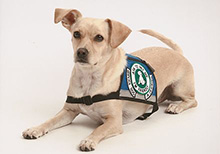
In the United States, the Americans with Disabilities Act defines a disability as "a physical or mental impairment that substantially limits one or more of the major life activities of such individual," and therefore allows handlers of psychiatric service dogs the same rights and protections afforded to those with other types of service animals. Service dogs, including psychiatric service dogs, are allowed to accompany their handler in any location that is normally accessible to the public whether or not health codes or business policy normally would allow a dog to enter, provided the dog behaves properly and does not interfere with normal operations (e.g. barking, biting, defecating, or obstructing other people) or pose a direct threat to the safety of others.
An alternative to a psychiatric service dog is an emotional support animal, which may or may not have specific training related to the handler's disability, but provides companionship and emotional support. They do not qualify as service animals in the United States, though they do qualify for several exceptions in housing and air travel.
The Fair Housing Act also allows tenants that have service animals or emotional support animals to stay in housing that does not allow pets. Some individual state laws may also provide additional guidelines or protection.
The Air Carrier Access Act also permits psychiatric service dogs and emotional support animals to be permitted to travel in the cabin when accompanied by a person with a disability.
Social Issues with Accessibility
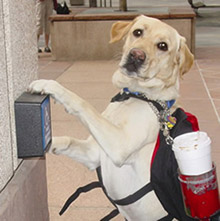
People with psychiatric service dogs are often faced with several problems that other service dog handlers typically do not experience. While guide dogs for the blind and hearing-impaired and helper dogs for people who use wheelchairs are well-known to the public, dogs for psychiatric conditions are not. Further adding to this issue is that many people with psychiatric conditions do not appear to have anything externally wrong with them, and because of the heavy social stigma of mental illness, the handler may be reluctant to explain their condition or the dog's trained tasks even in the vaguest of terms. In addition, the dogs can be any size (even toy breeds) depending on their trained task, yet there is a common public misconception that all service dogs are medium or large breeds. Any of these issues can lead to other people inappropriately impugning the dog's status or pressing the handler to divulge medical information about themselves
AUTISM SERVICE DOG
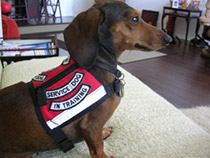
An autism service dog is a service dog trained to assist a person with autism, to help them gain independence, confidence, and the ability to perform activities of daily living similar to anyone else. For the most part, these dogs are trained to perform tasks similar to those of service dogs for other sensory processing disabilities.
Autism service dogs are trained to help the handler process sensory information. Many autism service dogs are trained in work/obstacle avoidance (similar to a guide dog) to help the handler with visual stimuli. Dog breeds recommended for those on the autism spectrum include: Labrador Retrievers, Golden Retrievers, Yorkshire Terriers, Standard Poodles, or other breeds of high intelligence.
As with hearing assistance dogs for the deaf, the dogs may also be trained to alert their handler to important noises or other things requiring human intervention, such as smoke or a smoke alarm, a crying baby, a telephone ringing, or a knock at the door. For a person with autism, it may not be immediately obvious which of the many external stimuli is the urgent one requiring their immediate attention. A person with autism may have to sort through both major and minor stimuli—the sound of crickets, the smell of the fabric softener on their clothes, a car driving past outside—to determine which of these, if any, needs their attention. They may understand that a smoke alarm is urgent and requires them to exit the building, but it might take more time.
How Service Dogs are Trained to Respond to Certain Behaviors:
| Behavior | Response |
|---|---|
| Self-stimulation | Will signal handler to behavior, handler may choose to stop |
| Self harming | Will interrupt behavior |
| Overstimulation / meltdown / shutdown | Deep pressure tasks: step on foot, paws on lap, lie on handler |
| Poor balance / motor control | Counterbalance, brace for stability |
| Disorientation | Find the car, go home, find other specified places |
| Auditory processing problems | Alert to important sounds |
| Visual processing problems | Guide work - steer around obstacles |
MOBILITY ASSISTANCE DOG
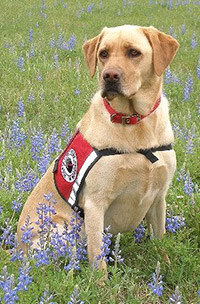
A mobility assistance dog is a service dog trained to assist a physically disabled person. Among other tasks, they are commonly trained to pick up objects, open and close doors, and operate light switches. Some larger-statured dogs are trained to pull individuals in wheelchairs, and wear a type of harness specifically designed for pulling.
Another type of mobility assistance dog task is that of a "walker dog". They are commonly used for Parkinson's patients, along with post-injury recovering and other disorders and conditions. These "living canes" can greatly assist a person with their gait and balance while walking. Also, if their handler falls, the dog may be trained to act as a brace to help regain position.
As with other types of assistance dogs, in many countries disabled individuals have the right to bring their mobility assistance dogs with them into places where animals are generally not allowed, such as public transportation, restaurants, and hotels. In the United States, the Americans with Disabilities Act is the law guaranteeing this opportunity to disabled individuals. If access is denied to a disabled individual, federal and some state laws have heavy penalties that may be brought against the business denying access.
In the UK, assistance dogs are trained and supported by charitable organizations; one such training mobility assistance dogs is Dogs for the Disabled.
Assistance Dogs International (ADI) "is a coalition of not for profit organizations that train and place assistance dogs." They publish a Guide to Assistance Dogs Laws which summarizes the federal and state-by-state laws pertaining to service dogs.
MEDICAL RESPONSE DOG
A medical response dog is a service dog trained to assist an individual who has a medical disability. Typically, they are dogs whose job does not handle primarily epilepsy or psychiatric-based conditions, though some seizure response dogs or psychiatric service dogs may also be referred to as medical response.

Many medical response dogs "alert" their handlers to conditions before they occur. For example, service dogs partnered with diabetic persons may be trained to detect when the handler's blood sugar becomes too high or low. In the UK, hypo alert dogs are used to alert their diabetic owners of dangerous changes in their blood sugar levels. In addition to or in the absence of this training, medical response dogs are also often trained skills to help in their handlers' symptoms, such as bringing medications or a telephone, providing bracing and other mobility assistance, or any other number of tasks.
Many medical response dogs may be trained by an organization or by their handler. Like all assistance dogs, they must be of a particular work-loving personality and be properly socialized if expected to work in public. There are no breed or size restrictions other than those directly related to the tasks needed.
The allowed public accessibility of medical response dogs varies from region to region. In general, areas with laws protecting the usage of guide dogs and other assistance dogs, such as in the United States, also cover medical response dogs as well.
EMOTIONAL SUPPORT ANIMAL
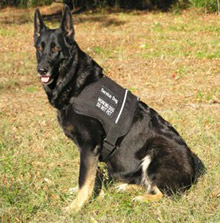
An emotional support animal (ESA) is a US legal term for a pet which provides therapeutic benefit to its owner through companionship and affection. Emotional support animals are not specially trained to ameliorate disability as psychiatric service dogs are. They require only as much training as an ordinary pet requires in order to live peacefully among humans without being a nuisance or a danger to others. In the U.S., two federal laws grant special rights to some owners of emotional support animals.
FAIR HOUSING ACT

The Fair Housing Amendments Act of 1988 (42 USC 3601, et seq.) establishes a procedure for modifying "no pets" policies in most types of housing to permit a person with a disability to keep an animal for emotional support. In housing that allows pets but charges supplemental rent or deposits for them, these fees must be waived. The ESA's owner can be charged for actual damage done by the animal, but they may not require the applicant to pay a fee or a security deposit in order to keep the animal.
The U.S. Department of Housing and Urban Development's Office of Fair Housing and Equal Opportunity investigates complaints from the public alleging denials of reasonable accommodation requests to live with assistance animals.
AIR CARRIER ACCESS ACT
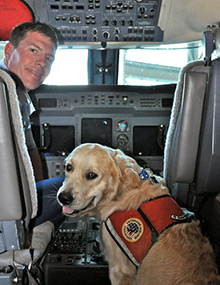
The Air Carrier Access Act establishes a procedure for modifying pet policies on aircraft to permit a person with a disability to travel with a prescribed emotional support animal so long as they have appropriate documentation and the animal is not a danger to others and does not interfere with others (through unwanted attention, barking, inappropriate toileting, etc.).
SERVICE DOG Q & A WITH KARMA DOG SERVICE DOG SUPERVISOR, KATHLYN ROSS
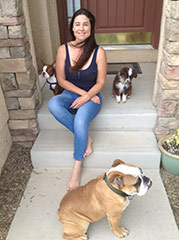
• How long have you been in the service dog business?
15yrs
• What inspired you to go in the business of training service dogs?
I first wanted to become a Marine Biologist however my math in college wasn't the greatest to successfully pass required classes to obtain that degree. I decided that I would try to become a Sea World trainer to at least gain experience in hope to take that experience to the research institute that I wanted to work at. I interviewed for a training position at Sea World for a show called "Pet's Rule". I was hired a few weeks later. We adopted rehabilitated and trained the dog's, cat's, pig's, duck's, pigeons, micaw birds that were in the show. Working 13 hr day's it started to become something I was passionate about; helping animals rehabilitating them and seeing them have fun doing the silly behaviors for the cute show. After Sea World I started immersing myself into all training a person could do with a dog.
• How do you interact differently with service dogs compared to non-service dogs when in training?
I personally don't change or have a difference in my deamenor. The types of behaviors the dog is trained to do is different between a service dog to a non-service dog.
• What might the process of finding dogs and training them look like?
Finding out first what service the dog will need to do then decide on the different breeds that have natural qualities that compliment the service needed. After that then it's finding and evaluating the dog.
• Describe a typical day you go through when working with the potential service dogs?
Knowing what is needed that day to work on then meeting the client to work on what the next step towards the dog being proficient in order to move on. This could be in home or out in public training, it just depends.
• What are some challenges you’ve faced when training the dogs?
No challenges perhaps more like being psychic to foresee when it will all of a sudden click in the dogs mind, since every dog is different.
• Explain your most rewarding experience you’ve had or witnessed with service animals?
Use specifics with the type of dog and its name. I trained a dog named Darby for a little boy who has life threatening nut allergies. Darby didn't show until he was 10M old that all the time and effort into training him clicked in his mind. I was so excited and happy that we were finally getting it done. Darby comes across very aloof however he learned how to alert 10 ft away as well as cross contamination. Seeing the little boy have more freedom to be a normal kid with a smart adorable 70lb Goldendoodle service dog was awesome. Their story is special.
• What is something you might want people to know about service dogs that they wouldn’t already know?
To not compare service dogs. That service dogs are not robots and can make mistakes and not think any less of the dog as a being if the dog makes the mistake.
• Is there anything I haven’t asked in the questions that you would like to say?
Service dogs have a title however every dog does a service for it's person, ask anyone who has a dog they will tell you all the wonderfulness their dog brings into their life.
SCHEDULE YOUR FREE 10 MINUTE
ZOOM, FACETIME, GOOGLE DUO, SKYPE,
OR PHONE CONSULTATION
Schedule Now
Contact UsEmily Ozrey
Director, Karma Dog Training
Director, Karma Dog Training




